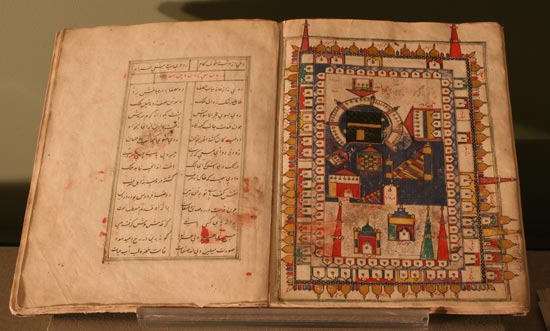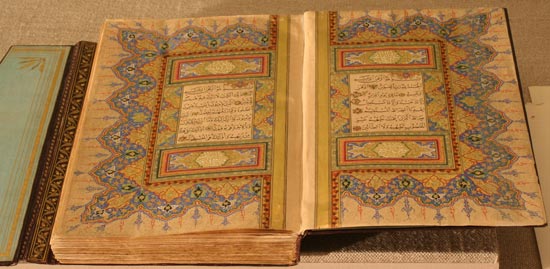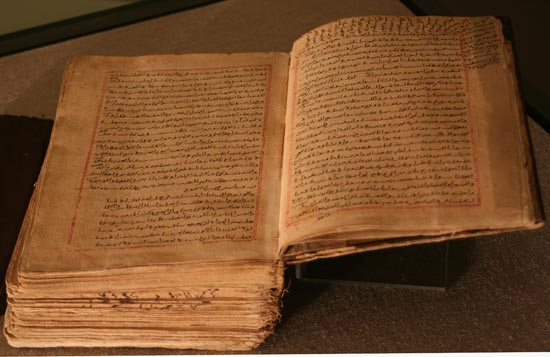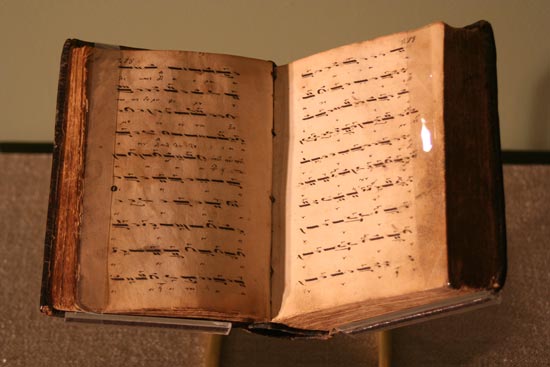RARE MANUSCRIPTS
More Collections
While Kelsey is well known for his collecting activities in classical antiquities and papyri, the University of Michigan also has him to thank for the bulk of its Islamic Manuscripts Collection. In 1923, Kelsey was offered an exquisite collection of manuscripts, supposedly from the personal collection of the Ottoman sultan Abdul Hamid II (r. 1876–1909), by the Cairo-based antiquities dealer Maurice Nahman. Kelsey traveled to London in March 1924 to discuss the possibility of a cooperative purchase with the British Museum and the collector Chester Beatty. A representative of the museum was dispatched to examine the collection, which comprised manuscripts of the highest level of artistry in binding, illumination, calligraphy, and illustration carrying works chiefly of Persian and Ottoman poetry, mysticism, and history.
In 1925, Professor Kelsey's contact at the British Museum brought his attention to an offer of more than 260 manuscripts made by the Orientalist and collector Abraham Shalom Yahuda on behalf of his brother, the Cairene bookseller Isaac Benjamin S. E. Yahuda. Chiefly in Arabic and dating from the Mamluk and Ottoman periods, the manuscripts were seen to supplement very well the University's manuscript holdings, so recently developed with the purchase of the Abdul Hamid manuscripts.
-

Depiction of Mecca in Futūḥ al-Ḥaramayn. Possibly Mecca, mid- to late 16th century The Special Collections Library, University of Michigan Library. Abdul Hamid Collection, Isl. Ms. 347
This richly illustrated copy of Futūḥ al-Ḥaramayn—a poetic account of the rites of pilgrimage (ḥajj) by the Persian writer Muḥyī al-Dīn Lārī (d. 1526 or 1527)—includes the depictions of holy sites and stations in the vicinity of Mecca and Medina, even Jerusalem, typical to copies of the work.
Though the manuscript is undated, the illustrations suggest that it was produced no earlier than the mid-16th century. In addition to incorporating renovations performed on the holy sites by the Ottoman sultan Süleyman I (r. 1520–1566), the paintings resemble those appearing in other copies produced in the mid- to latter part of the 16th century in Ottoman Arabia.
-

Illuminated opening of al-Qurʼān. Istanbul, 1892 The Special Collections Library, University of Michigan Library. Abdul Hamid Collection, Isl. Ms. 173
This exquisite manuscript is the 102nd mushaf (copy of the Qurʼān) executed by the Ottoman master of calligraphy Kayışzade Hafız Osman Nuri Efendi (d. 1894), which he completed in 1892. In addition to the Qurʼānic text in Hafız Osman Nuri Efendi's perfect nesih script, the manuscript includes notabilia, glosses, texts, and prayers at the close, which were transcribed by Pazarcıklı Mehmet Hulusi Efendi (d. 1908), well-known student of another great master, Mehmet Şevki Efendi (d. 1887).
The brilliant illuminations were completed slightly later that the text (1895 or 1896) by Hacı Ahmet, a student of the skilled illuminator Hacı Hüseyin Efendi (d. 1876), with whom Şevki Efendi is known to have collaborated.
-

al-Rubʻ al-thālith min al-Khiṭaṭ. Egypt, between 1415 and 1427 The Special Collections Library, University of Michigan Library. Yahuda Collection, Isl. Ms. 605
This manuscript contains the holograph fair copy of the third part of al-Mawāʻiẓ wa-al-iʻtibār fī dhikr al-khiṭaṭ wa-al-āthār (commonly known as al-Khiṭaṭ), chiefly a topographical description of Fusṭāṭ and Cairo (including its quarters, monuments, and the customs associated with them) by the celebrated Egyptian historian Taqī al-Dīn Aḥmad ibn ʻAlī al-Maqrīzī (d. 845/1442).
As a fair copy in al-Maqrīzī’s own hand, the manuscript is significant for study of his working method. It is the only known al-Maqrīzī holograph held in a North American collection and the only fair copy of the Khiṭaṭ reported to date. As such, it is one of the most noteworthy manuscripts in the entire Islamic Manuscripts Collection.
-

Facta et dicta memorabilia. Valerius Maximus (fl. 30 bc), vellum, 270 × 200 mm. Italy, 15th century The Special Collections Library, University of Michigan Library. Mich. Ms. 148
In a letter dated January 31, 1925, and addressed to University Librarian W. W. Bishop, Kelsey refers to the purchase of two Latin manuscripts from the antiquarian book dealer W. M. Voynich in the previous year, including this 15th-century manuscript of Valerius Maximus's Facta et dicta memorabilia. Arguably, this manuscript was acquired primarily for the artistic value of the illuminated initials. Here we see the first page of the text with the initial U of URBIS, which in turn contains a picture map of Rome. In the foreground is the Mulvian Bridge with scenes of daily life on both sides of the river Tiber. Within the city walls we can see the Pantheon at the right and the Coliseum at the left.
Kelsey delivered a paper describing this manuscript for the meeting of the American Philological Association in 1925. The paper was published under the title "A Picture Map of Rome in a Manuscript of Valerius Maximus" in Transactions of the American Philological Association 56 (1925).
-

Doxology. Petros Byzantios (fl. 18th century). Paper, 140 × 90 mm. Constantinople, end of 18th–first half of 19th century The Special Collections Library, University of Michigan Library. Mich. Ms. 11
Writing from London to University Librarian W. W. Bishop on September 24, 1920, Kelsey revealed that this manuscript was purchased from the antiquarian dealer I. E. Géjou in Paris in July 1920, at the end of the first expedition.
The content of the manuscript is attributed to Petros Byzantios, who was born in Neochorion of Bosphorus in the 18th century. Practically nothing is known about his life except that he was a student of the great singer, teacher, and composer of Byzantine music Petros Peloponnesios (ca. 1730–1778). In fact, Petros Byzantios began to compose his own works based on the musical scriptures of his teacher. Though most of Petros Byzantios's compositions were liturgical hymns, he also used other genres such as the Doxology. Strictly speaking, doxology means "glorification," and, in the context of Byzantine culture, it defines a liturgical formula of praise to be sung, particularly in the form of the concluding exclamation of a prayer. Doxologies were originally found in the New Testament and were eventually introduced in liturgical services and by the Church Fathers to conclude sermons.